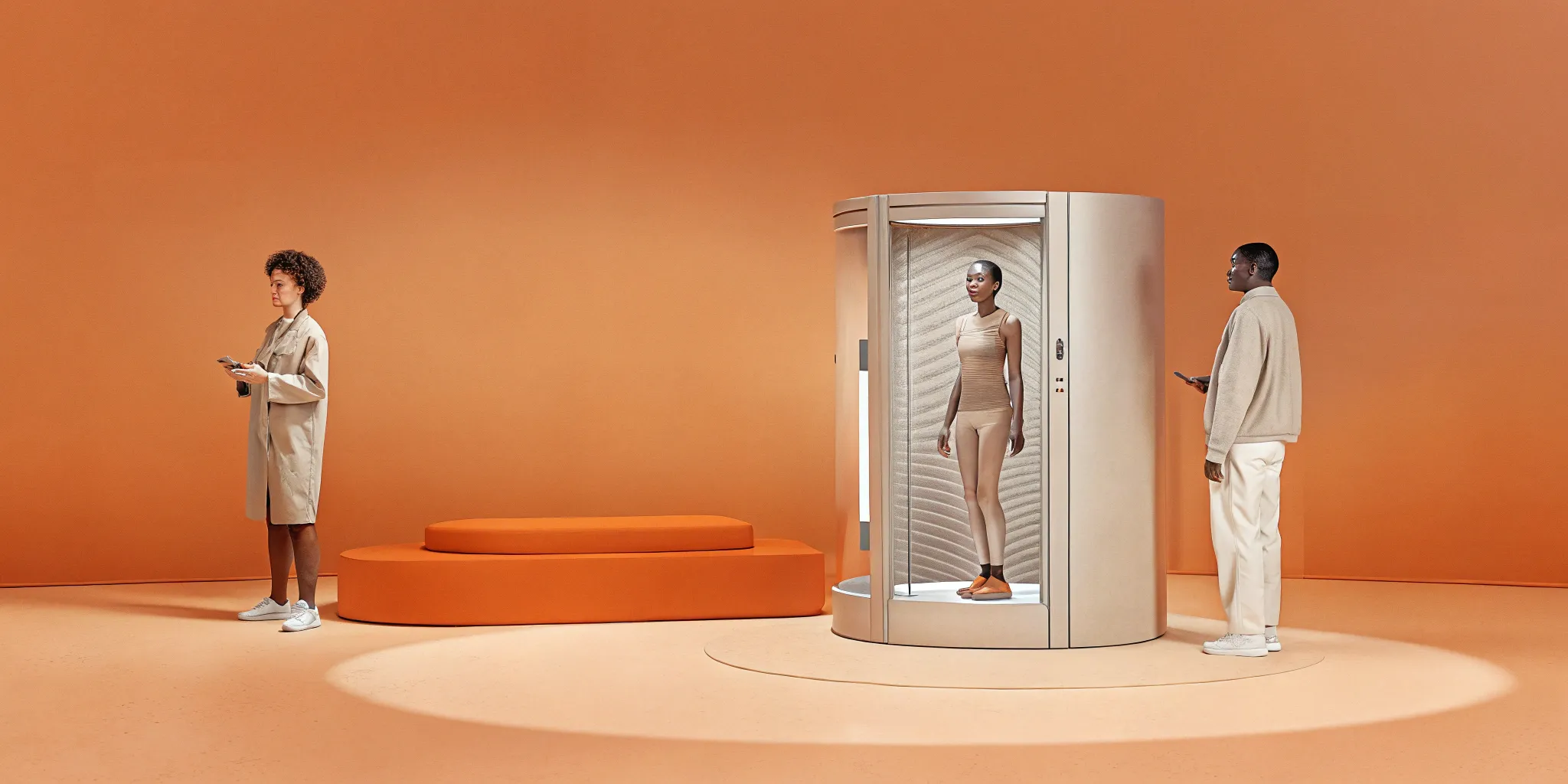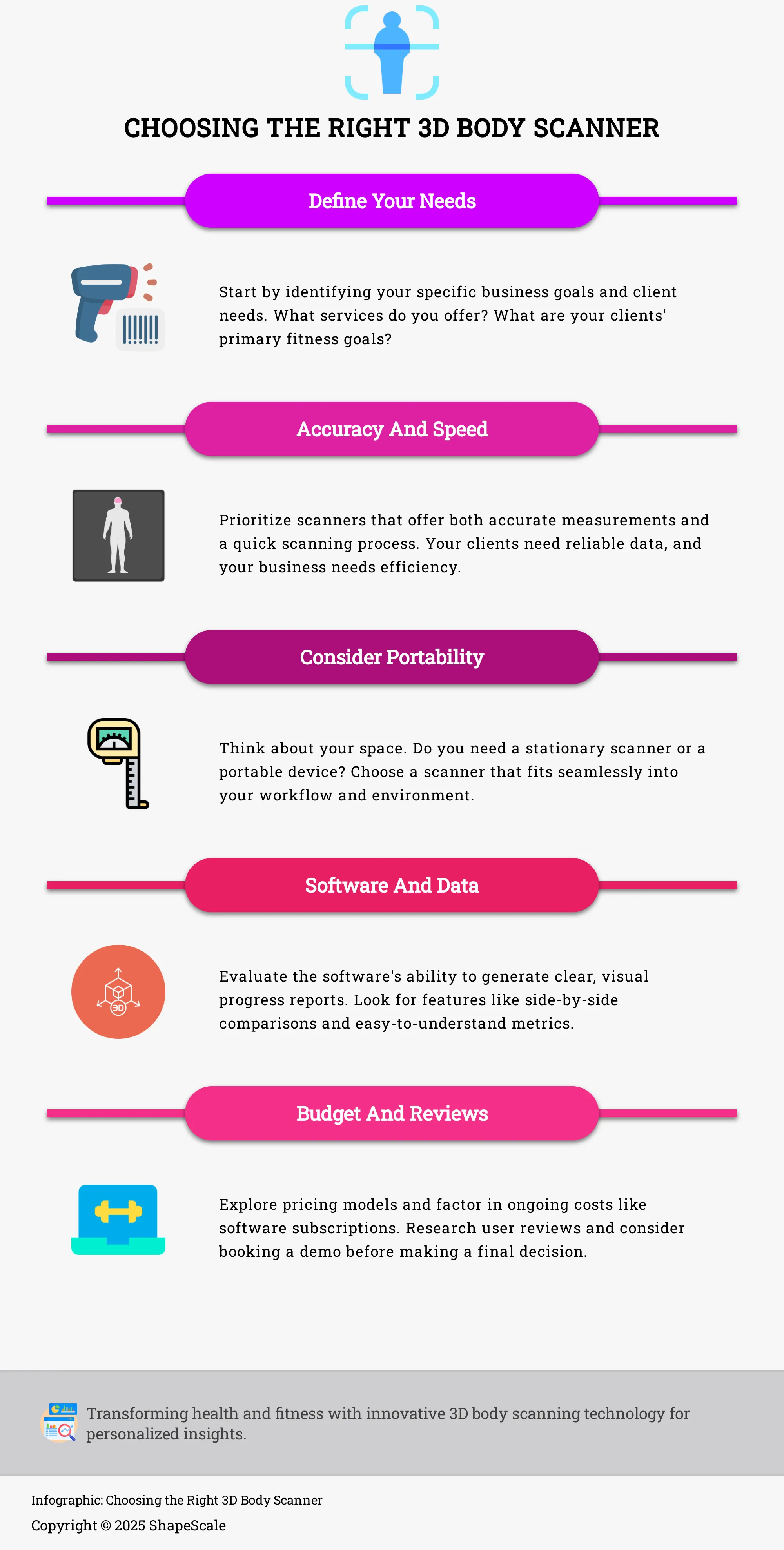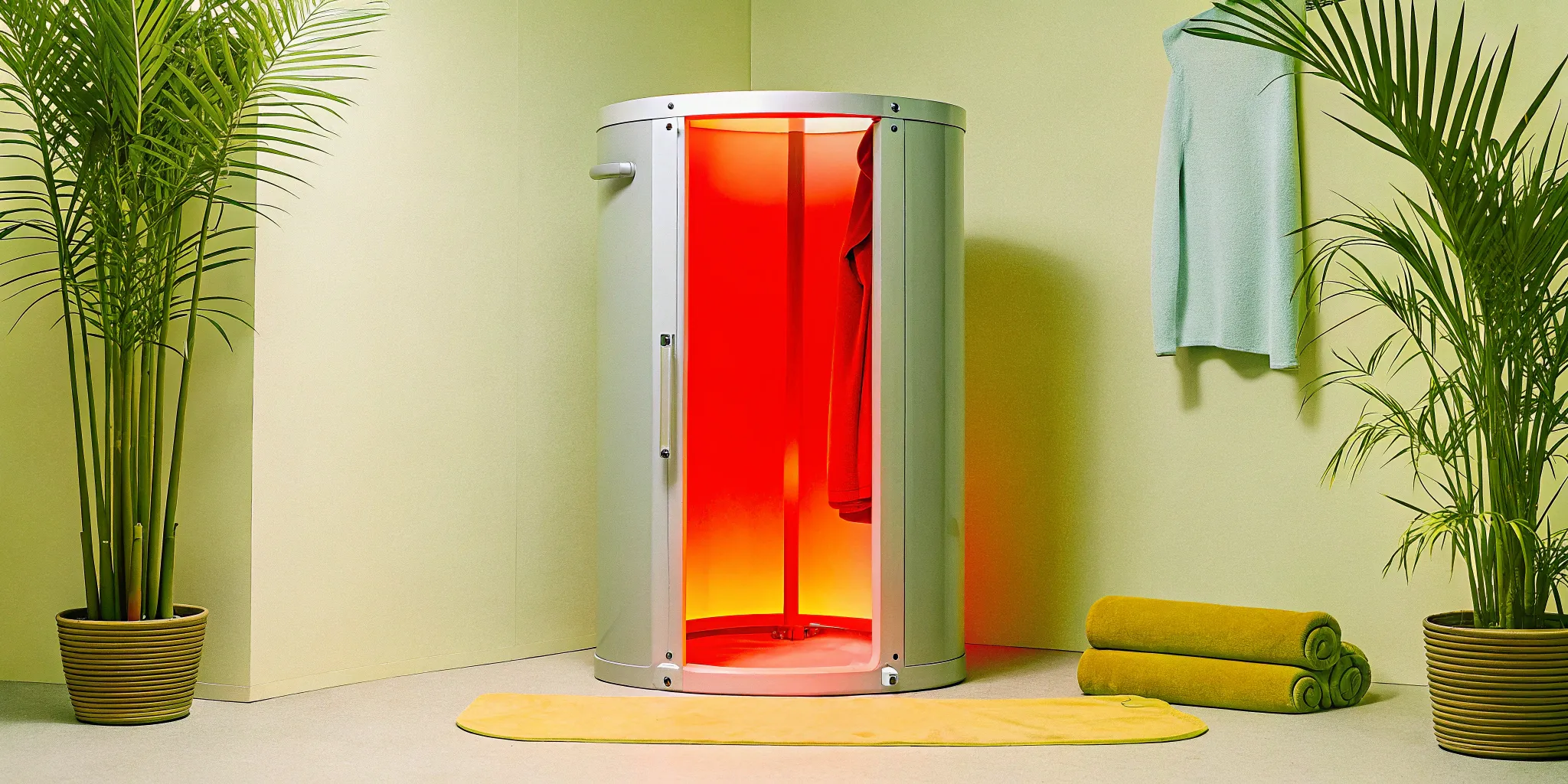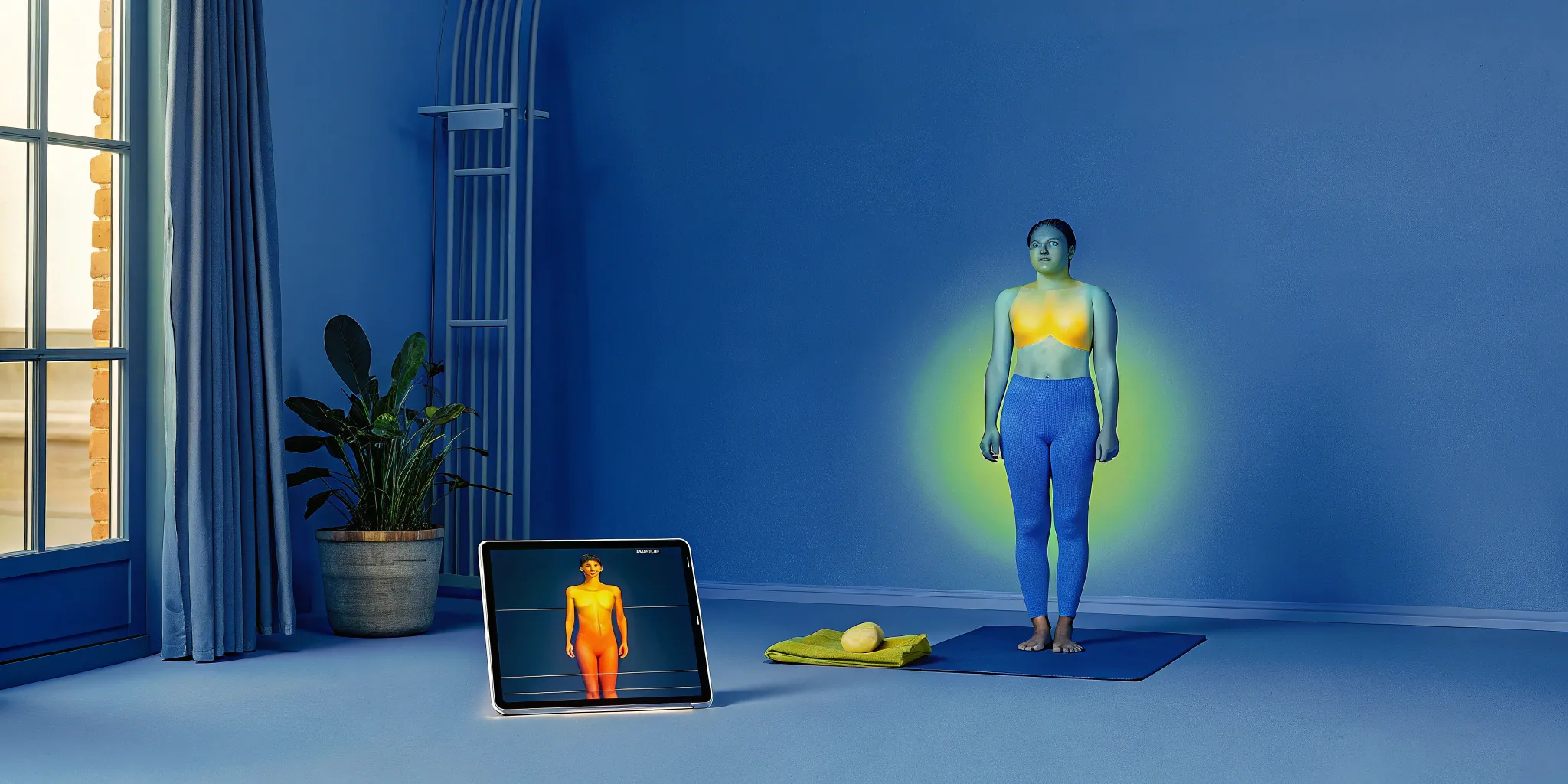7 Best 3D Body Scanners for Wellness Businesses


Heading 2
Heading 1
Heading 3
Heading 4
Heading 5
Heading 6
Lorem ipsum dolor sit amet, consectetur adipiscing elit, sed do eiusmod tempor incididunt ut labore et dolore magna aliqua. Ut enim ad minim veniam, quis nostrud exercitation ullamco laboris nisi ut aliquip ex ea commodo consequat. Duis aute irure dolor in reprehenderit in voluptate velit esse cillum dolore eu fugiat nulla pariatur.
Block quote
Ordered list
- Item 1
- Item 2
- Item 3
Unordered list
- zz
- Item B
- Item C
Bold text
Emphasis
Superscript
Subscript
Your client's journey is the heart of your business. Keeping them motivated from their first consultation to their final goal is essential for success. While traditional tracking methods have their place, they often lack the "wow" factor that builds lasting engagement. A 3D body scanner changes that dynamic completely. It provides a powerful, visual experience, allowing clients to see a photorealistic model of their transformation over time. This isn't just about data; it's about creating moments of celebration and reinforcing their commitment. By choosing the best 3d scanner for human body, you can offer a premium, tech-forward experience that builds trust, proves results, and sets your wellness business apart from the competition.
Key Takeaways
- Visualize progress to keep clients motivated: A 3D scanner shows changes in body composition, like fat loss and muscle gain, that a scale can't capture. This visual proof keeps clients engaged and validates their hard work.
- Choose a scanner that fits your services: The best device for a medical spa differs from what a personal trainer needs. Consider accuracy, speed, and software features to find a scanner that directly supports the services you offer your clients.
- Make scanning a core part of the client experience: Use the scanner from the first consultation to the final check-in. Weaving it into your process helps set clear goals, track results consistently, and build long-term client trust.
What is a 3D Body Scanner?
A 3D body scanner is a device that captures the precise shape and measurements of a person's body to create a detailed digital model. Think of it as a high-tech measuring tape that provides a complete, 360-degree view of a client's physique. For wellness businesses, this technology offers a way to move beyond the limitations of the bathroom scale and provide clients with a much richer understanding of their body composition and physical changes over time. It transforms abstract goals into tangible, visual progress.
This technology gives your clients a clear, data-driven picture of their journey, which is far more motivating than a single number on a scale. Instead of just tracking weight, you can show them exactly where they are losing fat and gaining muscle. This level of detail helps manage expectations, builds trust, and proves the value of your programs. By incorporating a 3D scanner, you give your business a distinct advantage, offering a premium, tech-forward experience that keeps clients engaged and committed to their goals.
How 3D scanners work
At its core, a 3D scanner uses sensors and cameras to capture hundreds of data points across the body's surface. Many systems, like ShapeScale, use a combination of a rotating platform and advanced computer vision to build a photorealistic 3D model in seconds. This process is completely non-invasive. The scanner's software then processes this information to extract highly accurate measurements, including body fat percentage, lean muscle mass, and specific circumferences. The result is a digital avatar that serves as a precise baseline, allowing you and your clients to track even the smallest changes over time with incredible detail.
Benefits over traditional measurement methods
Traditional methods like tape measures and calipers can be inconsistent and uncomfortable for clients. A 3D scan, on the other hand, is quick, private, and contactless. Its biggest advantage, however, is how it redefines progress. A standard scale can be misleading; a client might gain a pound of muscle and lose a pound of fat, but the scale will show no change, leading to frustration. A 3D scanner visualizes these body recomposition changes, showing clients exactly where they've lost fat and gained muscle. This visual feedback is a powerful motivator that keeps clients engaged and confident in your services.
Common uses in fitness and wellness
The applications for 3D body scanning are broad and impactful across the wellness industry. For personal trainers and health clubs, it’s an invaluable tool for setting baselines and demonstrating the effectiveness of workout plans. Weight management centers can provide clients with detailed reports on fat loss and changes in body shape that go beyond weight. For medical spas, scanners can visually track the results of body contouring procedures, helping to manage client expectations and showcase results. Ultimately, this technology helps you prove the value of your services, which can improve client retention and satisfaction.
A Review of the Top 3D Body Scanners
Choosing a 3D body scanner isn't a one-size-fits-all decision. The best device for a medical spa might differ from what a high-volume gym or a mobile personal trainer needs. Scanners vary widely in their core function, from providing detailed health metrics to creating high-resolution models for other applications. Understanding these differences is the first step in finding the right fit for your business and your clients. Below is a review of some of the top 3D body scanners on the market, highlighting what each does best and who it's for.
ShapeScale: For detailed body composition and progress tracking
ShapeScale is designed for wellness professionals who need to show clients clear, visual proof of their progress. It uses a combination of computer vision and a high-precision scale to create a photorealistic 3D model of the body. This allows you to track changes in muscle gain and fat loss with incredible detail—visualizing progress that a standard scale or measuring tape would miss. The platform provides detailed insights into body composition, including localized lean mass and fat mass measurements. This makes it an ideal tool for medical spas, personal trainers, and weight management centers focused on delivering and demonstrating results.
Artec Eva: For high-resolution, professional-grade scans
The Artec Eva is a professional-grade handheld scanner known for its ability to capture objects in high resolution and vibrant color. While not specifically designed for body composition, its precision makes it a powerful tool for applications requiring extreme detail, such as creating custom medical equipment or detailed anatomical models. Its ease of use and speed allow for quick, textured scans without the need for calibration. For a wellness business, the Eva is best suited for specialized medical or research applications rather than routine client progress tracking. It's a versatile but high-end device for capturing detailed 3D models of any object, including the human body.
Structure Sensor: For portable, on-the-go scanning
For professionals who need portability, the Structure Sensor offers a compelling solution. This compact scanner attaches to an iPad, turning it into a mobile 3D scanning device. It's designed for capturing 3D models of objects and spaces in real-time, making it highly flexible. For a personal trainer who visits clients at home or a physical therapist working in different rooms, this portability is a major advantage. While it may not offer the same level of body composition detail as stationary scanners, its convenience and versatility make it a popular choice for on-the-go professionals who need a quick and easy way to capture 3D body shapes.
Styku S100: For fitness and body shape analysis
The Styku S100 is a turntable-based scanner built specifically for the fitness industry. In about 35 seconds, it captures a client's body and provides a suite of measurements, shape analysis, and body composition estimates. Its software is geared toward goal-setting and progress visualization, making it a common sight in gyms and wellness centers. The system focuses on circumference measurements and body shape, helping users see how their bodies are changing beyond just weight. It's a strong tool for client engagement in a health club setting, offering a straightforward way to set goals and track progress over time.
Shapify Booth: For creating full-body 3D models
The Shapify Booth takes a different approach to 3D body scanning. Developed by Artec 3D, this is a fully automated, enclosed booth that captures a high-resolution, full-color 3D model of a person in just 12 seconds. The primary output is a "3D selfie" or a digital model that can be used to print a detailed figurine. While it captures precise body measurements, its main purpose is creating lifelike models rather than tracking health metrics. This makes the Shapify Booth more of a novelty or retail product than a clinical tool, though it could be a unique attraction for a large commercial facility.
Fit3D ProScanner: For comprehensive wellness assessments
The Fit3D ProScanner is another popular option for fitness and wellness centers, offering a comprehensive assessment in a single scan. The user stands on a turntable while a sensor captures a full 3D image. The system provides hundreds of measurements, a body shape rating, and a body composition analysis. It also includes posture analysis, which can be a valuable feature for personal trainers and physical therapists. The platform is designed to help clients understand their health beyond weight, providing a detailed wellness assessment that includes posture, balance, and body shape. This data helps create a holistic view of a client's starting point and progress.
Naked Labs Body Scanner: For at-home body scanning
Originally designed for the consumer market, the Naked Labs Body Scanner brought 3D scanning into the home. It consists of a rotating scale and a mirror with built-in sensors, allowing users to perform scans in private. The system tracks body fat percentage, lean mass, fat mass, and various circumference measurements. While it's an at-home device, wellness professionals should be aware of it, as clients may use it to track their own progress between appointments. Understanding the data from these at-home body scanners can help you have more informed conversations with clients about their journey and the technology they use outside of your facility.
How to Choose the Right 3D Body Scanner

Selecting a 3D body scanner is a significant investment for your wellness business. The right technology can transform your client experience and provide unparalleled insights, but the wrong one can lead to frustration and wasted resources. With so many options available, each with different strengths and features, it’s easy to feel overwhelmed. To make the best choice for your medical spa, health club, or personal training business, consider these key factors. Thinking through each one will help you find a scanner that aligns with your business goals, budget, and the needs of your clients.
Accuracy and resolution
For wellness professionals, accuracy is non-negotiable. Your clients rely on you for precise tracking, and the data you provide must be trustworthy. High-resolution scanners capture incredible detail, creating a photorealistic 3D model of the body. This allows you to measure changes in body composition with a high degree of precision, showing clients tangible proof of their hard work beyond the number on a scale. Technologies like ShapeScale use advanced optical scanning to deliver detailed insights into muscle gain and fat loss, which is essential for keeping clients motivated and demonstrating the value of your services.
Speed and usability
In a busy wellness center, efficiency is key. A 3D scanner should fit seamlessly into your workflow, not slow it down. Look for a device with a quick scanning process—some can capture a full-body model in under a minute. The software interface should also be intuitive for both your staff and your clients. A complicated or lengthy procedure can create a poor customer experience and discourage regular use. For health clubs and gyms with high member traffic, a fast and user-friendly scanner is essential for smooth operations.
Portability and size
Consider the physical space in your facility. Do you have a dedicated room for a large, stationary scanner, or do you need something more compact? Some scanners are large booths, while others are smaller, freestanding units or even handheld devices. Portability can be a major advantage for personal trainers who work with clients in different locations or for businesses with limited square footage. Before you buy, measure your available space and think about how and where the scanner will be used day-to-day to ensure it’s a practical fit for your environment.
Software and data options
The scanner's hardware is only one part of the equation; the software is what turns raw data into actionable insights. The best platforms use sophisticated algorithms to analyze the 3D model and provide detailed metrics on body composition, posture, and circumference measurements. Look for software that offers clear, visual progress reports, like color-coded heatmaps showing where a client is losing fat or gaining muscle. This kind of fitness 3D scanning data makes it easier to educate clients, adjust their plans, and celebrate their achievements along the way.
Price and budget
3D body scanners represent a wide range of price points. When evaluating the cost, think beyond the initial purchase price. Ask about ongoing software subscription fees, maintenance costs, and warranty options. It’s helpful to frame the investment in terms of its potential return. A scanner can become a new revenue stream if you charge for scans, or it can serve as a powerful retention tool that sets your business apart from competitors. Explore the different pricing models available to find one that aligns with your budget and business strategy.
User reviews and reputation
Before making a final decision, do your homework. Read reviews and testimonials from other wellness professionals who have used the scanners you’re considering. Look for case studies from businesses similar to yours, whether it’s a medical spa, a gym, or a weight management clinic. A company’s reputation for customer support and training is also critical. A great way to vet a product and the team behind it is to book a demo. This gives you a firsthand look at the technology and a chance to ask specific questions about how it can benefit your business.
Get the Most Out of Your 3D Scanner
A 3D body scanner is a powerful tool, but its value comes from how you use it. Simply having one in the corner of your facility isn’t enough. To see a real return on your investment, you need a clear strategy for integrating the scanner into your business operations and client journeys. From defining your goals upfront to staying on top of new technological developments, a thoughtful approach will ensure your scanner becomes an indispensable asset for both your team and your clients.
Define your business needs first
Before you invest in a 3D body scanner, take a moment to map out your specific needs. Think about the services you offer and your primary clientele. Are you a medical spa focused on body contouring, or a gym helping members build muscle? Your goals will determine which features are most important. A clear understanding of how the scanner will support your existing services helps you choose the right device and create a seamless workflow. This initial planning ensures the technology doesn't just sit there—it actively helps you achieve your business objectives and better serve your clients.
Tips for proper use and maintenance
To build client trust, your scanner’s data must be accurate and reliable. The key is to standardize the scanning process. Create a consistent environment with stable lighting and make sure the device is calibrated correctly before each use. Proper staff training is also essential so that every team member can guide clients through the process correctly. When clients get consistent, repeatable results, they gain confidence in the measurements and in your facility’s professionalism. A well-maintained scanner and a standardized process are fundamental to delivering a high-quality service. You can often book a demo with providers to learn these best practices.
Integrate scanning into your client experience
Make the 3D scanner a central part of your client's journey. Use it during the initial consultation to set a baseline and establish clear, measurable goals. Then, schedule regular follow-up scans to visually track progress. This data allows you to offer personalized feedback and adjust programs accordingly. For many clients, seeing a 3D model of their transformation is more motivating than a number on a scale. This deepens engagement and can lead to better retention and higher conversion rates for services like personal training packages. The scanner becomes a tool for motivation, accountability, and celebration.
What's next for 3D body scanning?
The world of fitness 3D scanning is constantly advancing. Innovations in machine learning and computer vision are making scanners more accurate, faster, and easier to use. As the technology evolves, new features and data insights will become available, offering even more value to you and your clients. Keeping an eye on these trends will help your business stay ahead of the curve. Think of your scanner not as a static piece of equipment, but as an evolving platform that can grow with your business and continue to provide a premium, data-driven experience for years to come.
Frequently Asked Questions
Why should I invest in a 3D scanner when my clients already use a scale? A scale only tells a small part of the story and can often be discouraging for clients. When a client loses a pound of fat and gains a pound of muscle, a scale shows no change, which can kill their motivation. A 3D scanner visualizes these body recomposition changes, providing clear proof that your programs are working. This visual evidence is a powerful tool for client retention because it demonstrates the value of your services in a way a simple number never can.
How can I justify the cost of a 3D scanner for my business? Think of a 3D scanner less as an expense and more as an investment in your business's growth. It can create a new revenue stream if you decide to offer scans as a standalone service. More importantly, it serves as a powerful marketing and retention tool that sets you apart from competitors. The detailed, professional reports and visual progress tracking elevate your client experience, making your services feel more premium and results-driven, which can justify higher price points.
Will my staff need special training to operate a 3D scanner? Most modern scanners are designed to be user-friendly and don't require extensive technical certification. The most important training for your staff will be on standardizing the scanning process to ensure consistent, reliable results for every client. They should also be comfortable explaining the process to clients and interpreting the visual reports in a way that is encouraging and easy to understand. Many providers offer training and support to get your team up to speed quickly.
How do I make sure my clients feel comfortable during the scanning process? Client comfort is key to making the scanner a positive part of their experience. It’s best to set up the scanner in a private, dedicated space. Before their first scan, walk them through exactly what to expect so there are no surprises. Frame the scan as a progressive tool for tracking their success, not as a judgment. When clients see it as a data-driven way to celebrate their hard work, they are more likely to feel confident and engaged in the process.
What's the most important feature to look for in a scanner's software? While many scanners offer a long list of metrics, the most critical software feature is its ability to generate clear, visual, and easy-to-understand progress reports. Look for software that can create side-by-side 3D model comparisons or color-coded heatmaps that show exactly where a client has lost fat or gained muscle. Data is only useful if it tells a story, and the best software helps you and your client see that story unfold visually.




